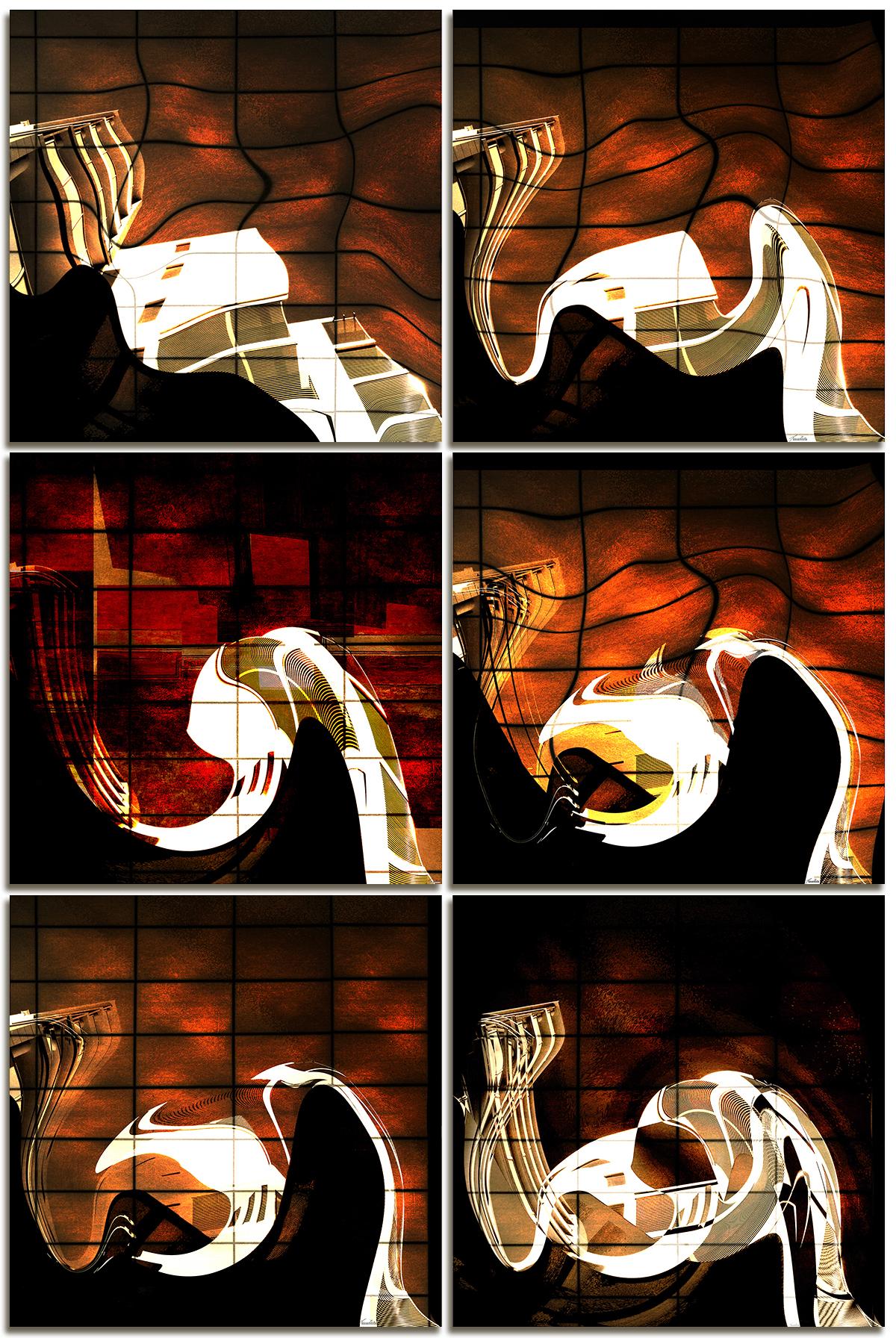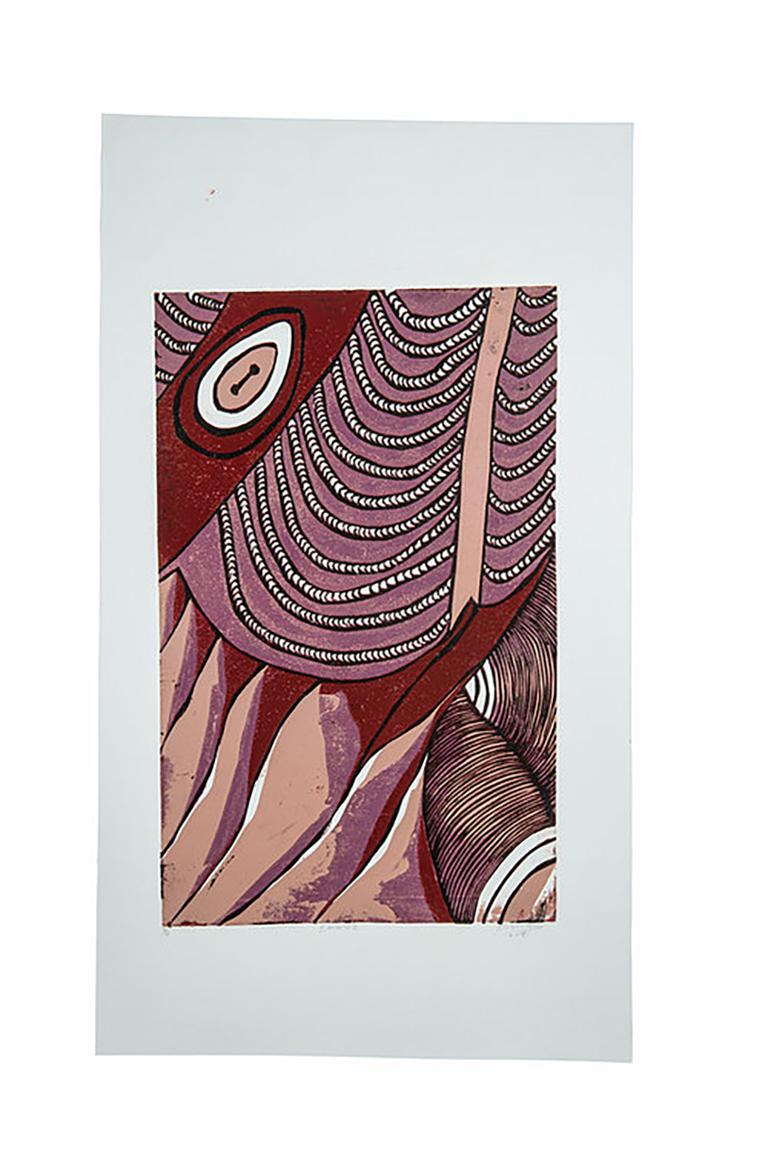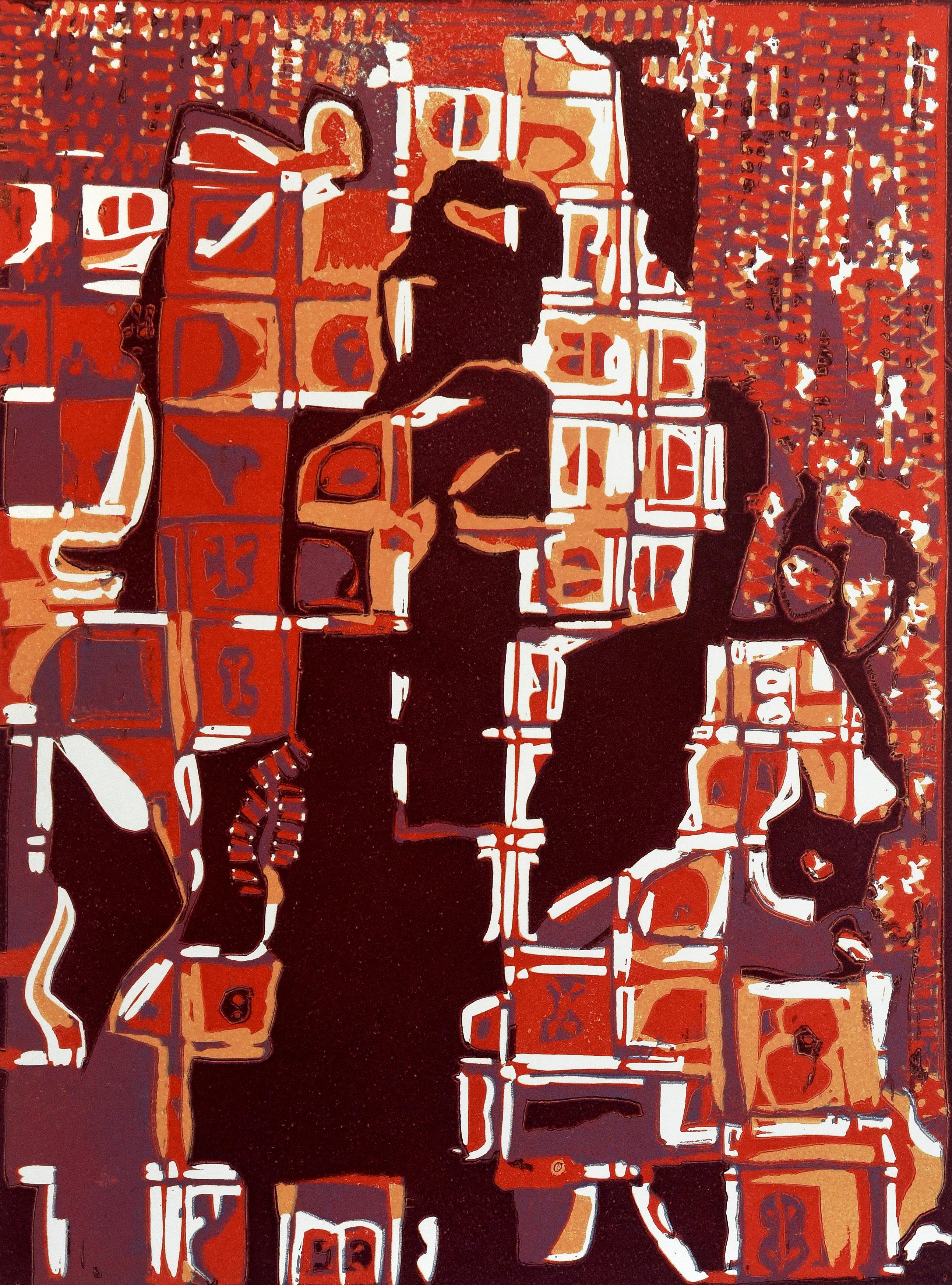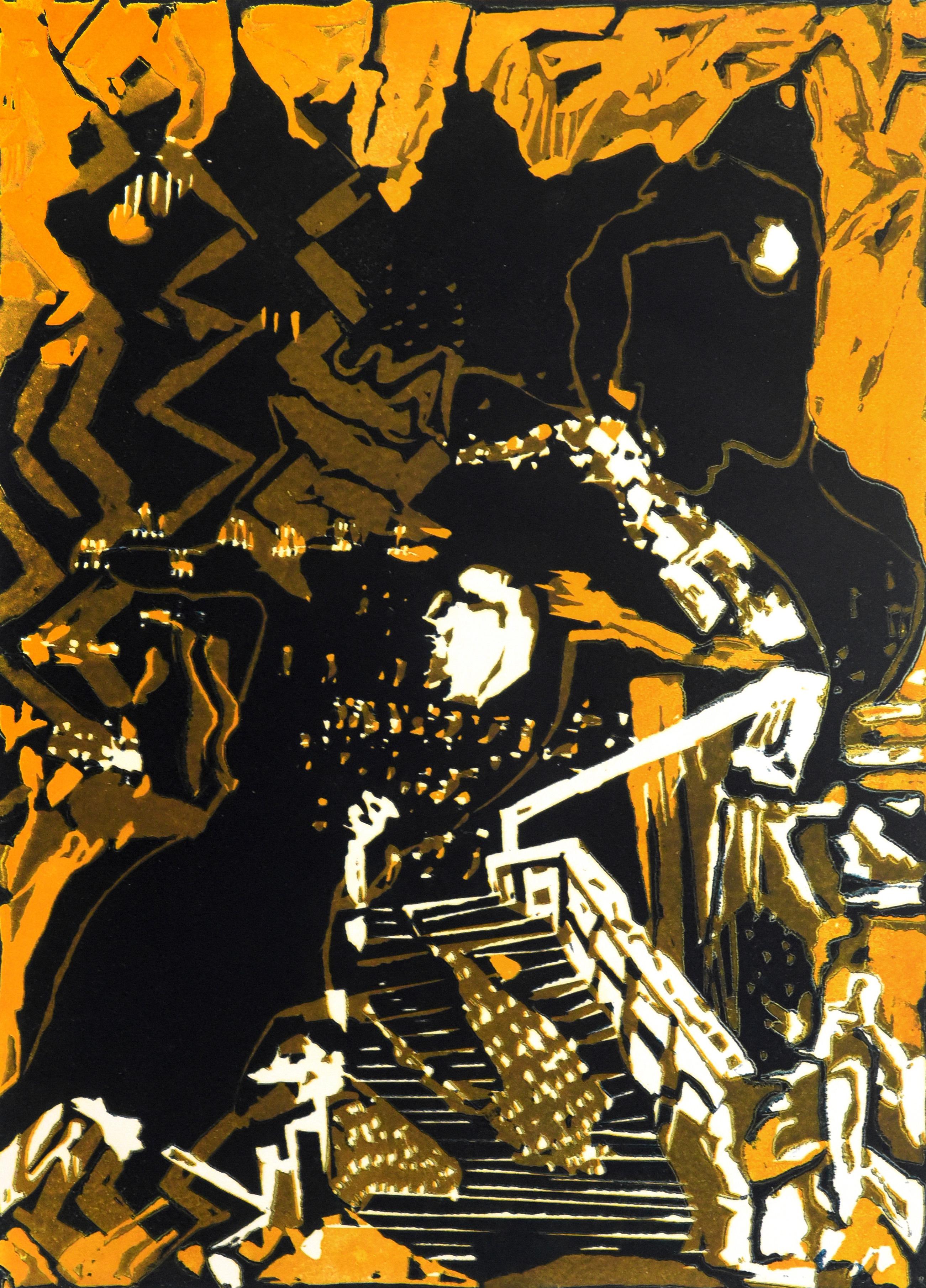Items Similar to Joyce T. Nagel Print "Vegetable Forms No. 9" "1st State" Signed Dated Ltd Ed
Want more images or videos?
Request additional images or videos from the seller
1 of 10
Joyce Tilley NagelJoyce T. Nagel Print "Vegetable Forms No. 9" "1st State" Signed Dated Ltd Ed1972
1972
About the Item
"Vegetable Forms No. 9" "1st State" is a beautiful linear design woodcut of an artichoke. What is intellectually interesting is the fractal beauty of nature found in the artichoke. A fractal is a kind of pattern that we observe often in nature and in art. Whenever you observe a series of patterns repeating over and over again, at many different scales, and where any small part resembles the whole, that’s a fractal. The Artichoke is the perfect example in that the shape of the leaves repeat themselves and they are the same shape as the fruit itself. Fractals are exciting, not only for their mathematical or conceptual representation, but also for the fact that you can visualise the math—and it’s beautiful! This print is rendered in an intense green with a light blue color to delineate the intriguing linear element of the artichoke's leaves.
Joyce Tilley Nagel received a BS in Advertising Design from Rochester Institute of Technology and an MA in Printmaking from Wayne State University, Detroit, Michigan. She has worked as a freelance graphic designer and has been recognized nationally for her fine art pastels.
Joyce is, also, known as an enthusiastic and knowledgeable teacher with a sensitive approach to drawing, printmaking, oil and pastel painting. In the late 60’s Joyce was an instructor at the Birmingham Bloomfield Art Association. In the 70’s and 80’s she taught adults drawing, design, printmaking and pastel painting. In the late 80’s and 90’s, Joyce, along with her husband, Don Nagel, led travel groups, as artist/demonstrators, through Europe to Paris, Northern France, Giverny and Provence.
She is a past president of Birmingham Society of Women Painters and was on the Birmingham Bloomfield Art Association Board, where she organized many exhibitions (Prints & Plates), and did graphics and production for their monthly publications, exhibitions and events. During these years, Joyce worked as a freelance graphic designer. She worked through Cranbrook Press on Christ Church Cranbrook monthly communications.
According to Joyce, “In the 70’s, monoprints became popular and more fun to create than doing repetitive editions. Wiping the plate was an individual procedure that I enjoyed for both abstracts and real images. Thus, each print is unique.” Her collection of monoprints provides a classic snapshot of mid-century art and design.
Today, she and husband Don, also an artist, are semi-retired, living and still painting on Hilton Head Island in South Carolina.
- Creator:Joyce Tilley Nagel (American)
- Creation Year:1972
- Dimensions:Height: 25.5 in (64.77 cm)Width: 23 in (58.42 cm)
- Medium:
- Movement & Style:
- Period:
- Condition:
- Gallery Location:Detroit, MI
- Reference Number:1stDibs: LU1286112874162
About the Seller
5.0
Vetted Seller
These experienced sellers undergo a comprehensive evaluation by our team of in-house experts.
Established in 2014
1stDibs seller since 2019
96 sales on 1stDibs
Typical response time: 5 hours
- ShippingRetrieving quote...Ships From: Detroit, MI
- Return PolicyA return for this item may be initiated within 14 days of delivery.
More From This SellerView All
- Joyce T. Nagel Collagraph "Earthcore" Signed Dated Ltd EdLocated in Detroit, MI"Earthcore" is an abstract of a familiar image ... a view of earth sliced in half usually as an explanation of the many layers of spaceship earth. This print is more than its title. It is rich in its depth of color and texture. Upon close inspection there is much activity on the surface which continually adds to its visual complexity. The name given to this print process is “Collagraph” It is made by glueing different materials to cardboard and creating a kind of collage. During the inking process the ink will rub off surfaces that are smooth or higher and stay on surfaces that hold more ink, at edge and at lower points thus creating the image. To protect the plate through the printing process it’s sealed with one or more layers of shellac. A collagraph plate is quite sensitive and will be deformed by the pressure of the printing press. Joyce Tilley Nagel...Category
1960s Abstract Expressionist Abstract Prints
MaterialsPaper, Ink
- Joyce T. Nagel Collagraph "Grid Melt" Deep Rich Colors Signed DatedLocated in Detroit, MI"Grid Melt" is one of the monoprints that Joyce Nagel so enjoyed creating. Being a monoprint makes this piece totally unique and unlike any of the other pi...Category
1980s Abstract Prints and Multiples
MaterialsPaper, Ink
- Joyce T. Nagel Monoprint Abstract "Dropout" Signed DatedLocated in Detroit, MI"Dropout" is one of the monoprints that Joyce Nagel so enjoyed creating. This monoprint is a one-off abstract print. The arrangement of shapes and colors p...Category
1980s Abstract Expressionist Abstract Prints
MaterialsPaper, Ink
- "Indianapolis Museum of Art Inaugural Exhibitions", Color Silkscreen, SignedBy Robert IndianaLocated in Detroit, MI"Indianapolis Museum of Art Inaugural Exhibitions", 25 October 1970, is an eye popping large bold colorful geometric abstract silk screen. It is signed on the lower right. Robert Indiana, one of the preeminent figures in American art since the 1960s, played a central role in the development of assemblage art, hard-edge painting, Pop art, Neo-Dada, American Modernism and Modern Art. A self-proclaimed “American painter of signs,” Indiana created a highly original body of work that explores American identity, personal history, and the power of abstraction and language, establishing an important legacy that resonates in the work of many contemporary artists such as Andy Warhol, Keith Haring, Roy Lectenstein, David Hockney, Romero Britto, Richard Hamilton and Robert Rauschenberg who make the written word a central element of their oeuvre. Robert Indiana was born Robert Clark in New Castle, Indiana on September 13, 1928. Adopted as an infant, he spent his childhood moving frequently throughout his namesake state. At 14 he moved to Indianapolis in order to attend Arsenal Technical High School, known for its strong arts curriculum. After graduating he spent three years in the U.S. Air Force and then studied at the Art Institute of Chicago, the Skowhegan School of Sculpture and Painting in Maine, and the Edinburgh College of Art in Scotland. In 1956, two years after moving to New York, Indiana met Ellsworth Kelly, and upon his recommendation took up residence in Coenties Slip, where a community of artists that would come to include Kelly, Agnes Martin, James Rosenquist, and Jack Youngerman had studios. Indiana, like some of his fellow artists, scavenged the area’s abandoned warehouses for materials, creating sculptural assemblages from old wooden beams, rusted metal wheels, and other remnants of the shipping trade that had thrived in Coenties Slip. The discovery of 19th century brass stencils led to the incorporation of brightly colored numbers and short emotionally charged words onto these sculptures as well as canvases, and became the basis of his new painterly vocabulary. Although acknowledged as a leader of Pop, Indiana distinguished himself from his Pop peers by addressing important social and political issues and incorporating profound historical and literary references into his works. In 1964 Indiana accepted Philip Johnson’s invitation to design a new work for the New York State Pavilion at the New York World’s Fair, creating a 20-foot EAT sign...Category
1970s American Modern Abstract Prints
MaterialsPaper, Ink, Screen
- Joyce T. Nagel Print "Orange" AP 1 Artist's Proof Handmade Paper Signed DatedLocated in Detroit, MI"Orange" is marked AP 1 meaning it was the print pulled and approved by the artist before additional prints were made. It is a colorful and lively abstract arrangement of circles and squares and printed on hand-made paper. Joyce Tilley Nagel...Category
1970s Modern Abstract Prints
MaterialsInk, Paper
- Joyce T. Nagel Collagraph Embossed "Telescoping Triangle"Located in Detroit, MI“Telescoping Triangle” is a stunningly interesting work of art in deep muted shades of alizarin crimson and gray with slashes of black. The embossed design adds depth and complexity to the piece in which two basic shapes of the universe, the rectangle and the triangle, are the main pattern and then repeated in various sizes and placement in the impressed image. The name given to this print process is “Collagraph” It is made by glueing different materials to cardboard and creating a kind of collage. During the inking process the ink will rub off surfaces that are smooth or higher and stay on surfaces that hold more ink, at edge and at lower points thus creating the image. To protect the plate through the printing process it’s sealed with one or more layers of shellac. A collagraph plate is quite sensitive and will be deformed by the pressure of the printing press. Joyce Tilley Nagel...Category
1980s Abstract Prints
MaterialsPaper, Ink
You May Also Like
- "Heatwave Sextych" - Abstract digital photomontage in dark colors. 6 art panels.By Marvin BerkLocated in Miami, FLLimited edition (18 signed and numbered prints + two artist proofs). This image is from Marvin Berk's "Heatwave" series. Flawless original signed and numbered prints. This art work c...Category
2010s Abstract Abstract Prints
MaterialsPaper, Archival Ink
- Emona 2, Elisia Nghidishange, relief print on paper, inkBy Elisia NghidishangeLocated in Windhoek, NAEmona 2, 2018. Cardboard block print on paper. Editions 2/4, 3/4, 4/4 available Elisia Nghidishange was born in Eenhana in northern Namibia. This printmaker, sculptor and mixed medi...Category
21st Century and Contemporary Abstract Abstract Prints
MaterialsPaper, Ink
- Fight over inheritance (i) & (ii), Elisia Nghidishange, relief print on paperBy Elisia NghidishangeLocated in Windhoek, NAFight over inheritance (i) & (ii), 2017. Cardboard block print on paper Elisia Nghidishange was born in Eenhana in northern Namibia. This printmaker, sculptor and mixed media artist...Category
21st Century and Contemporary Abstract Abstract Prints
MaterialsPaper, Ink
- Handmade Cutouts Monotype, Blue and White Moonlight Reflection Contours, UniqueBy Kind of CyanLocated in Barcelona, ESThis is an exclusive handprinted unique cyanotype that takes its inspiration from mid-century modern shapes. It's made by layering paper cutouts and different exposures using uv-ligh...Category
2010s Abstract Geometric Abstract Prints
MaterialsPhotographic Film, Photogram, Monotype, Color, C Print, Photographic Pap...
- Abstract Landscape India Edition 3/5 Linocut Print Nature Red Orange BlackBy Mukesh SharmaLocated in Norfolk, GBThere is a natural and raw understanding in Mukesh Sharma’s prints that both depict, and are influenced by, the Rajastani communities of his home town in rural India. In these Limited Edition fine-art prints, made over a period of twenty years, we are offered the colours of India’s ancient land, the textures, light and the patterns that are everywhere. In the patterns of the arable fields to the jali's (carved screens) in the architecture. This work is however not romantic nor nostalgic but shows a deeper rooted need to offer a visual heritage of place, of where the artist is from and the journey that he is taking. The results are both compelling and honest. Mukesh Sharma, Celebration “O”, Lino-cut chin-coll’e on German Ivory paper Edition: 3 of 5, 2005 Image size: 50 x 33 cm / Sheet size: 79 x 55 cm Unframed "In this piece I use multiple layering of image, repetition of shape, layered shapes to inform my life celebration and my investigation into Indian culture" Mukesh Sharma's work: It is often in childhood that paths are set for what we will become. Mukesh Sharma hails from a rural, agricultural village in Rajasthan, India. His Father is a craftsman who fixed and mended farm machinery and understood the working parts in the processes. Sharma followed in his Father’s footsteps, as is often the case in Indian families, but his was not the machines of the fields but the presses of the printing studio. Like his Father, Mukesh Sharma is fascinated with understanding how things work and how he can manipulate the metal in his hands. It is not surprising then that his medium of choice is printing. One of the most physically challenging of all the practices, it can often be physically challenging as well as technical and detailed. In his youth, Sharma would draw with stones on walls and floors. He was lucky his family encouraged this and he is grateful for his early art-training at the Jaipur School of Art but it was at the Baroda Art Department that he was introduced to the great printing traditions of Jyoti Bhatt...Category
Early 2000s Abstract Abstract Prints
MaterialsArchival Ink, Archival Paper, Linocut, Archival Pigment
- Abstract Landscape Indian Art Edition 3/5 Linocut Print Nature Orange AustraliaBy Mukesh SharmaLocated in Norfolk, GBThere is a natural and raw understanding in Mukesh Sharma’s prints that both depict, and are influenced by, the Rajastani communities of his home town in rural India. In these Limited Edition fine-art prints, made over a period of twenty years, we are offered the colours of India’s ancient land, the textures, light and the patterns that are everywhere. In the patterns of the arable fields to the jali's (carved screens) in the architecture. This work is however not romantic nor nostalgic but shows a deeper rooted need to offer a visual heritage of place, of where the artist is from and the journey that he is taking. The results are both compelling and honest. Mukesh Sharma, Jetty 1, Lino-cut chin- coll’e on German Ivory paper Edition: 3 of 5, 2005 Image size: 50 x 33 cm / Sheet size: 79 x 55 cm Unframed ''What mesmerised me was the meeting of the sea and the mountain peak. Where the Jetty, a special curved wooden staircase leading to one end and the deep crystal clear sea at a distance. These scenes were amazing to me." Mukesh Sharma's work: It is often in childhood that paths are set for what we will become. Mukesh Sharma hails from a rural, agricultural village in Rajasthan, India. His Father is a craftsman who fixed and mended farm machinery and understood the working parts in the processes. Sharma followed in his Father’s footsteps, as is often the case in Indian families, but his was not the machines of the fields but the presses of the printing studio. Like his Father, Mukesh Sharma is fascinated with understanding how things work and how he can manipulate the metal in his hands. It is not surprising then that his medium of choice is printing. One of the most physically challenging of all the practices, it can often be physically challenging as well as technical and detailed. In his youth, Sharma would draw with stones on walls and floors. He was lucky his family encouraged this and he is grateful for his early art-training at the Jaipur School of Art but it was at the Baroda Art Department that he was introduced to the great printing traditions of Jyoti Bhatt...Category
Early 2000s Abstract Abstract Prints
MaterialsArchival Ink, Archival Paper, Linocut, Archival Pigment
Recently Viewed
View AllMore Ways To Browse
Vintage 90S Patterns
Vintage Vegetable Art
Vegetable Plate
Plates With Vegetables
French Vintage Advertising Signs
Vegetable Print
Vegetable Drawing
Fruit Vegetables
Fruit And Vegetables
Vintage Cranbrook
Vintage Fruit Prints
70s Womens
Vintage 90s Drawings
Fractal Collection
Vintage Vegetable Sign
Vintage Vegetable Signs
Nagel Vintage
Abstract Fruit Print





